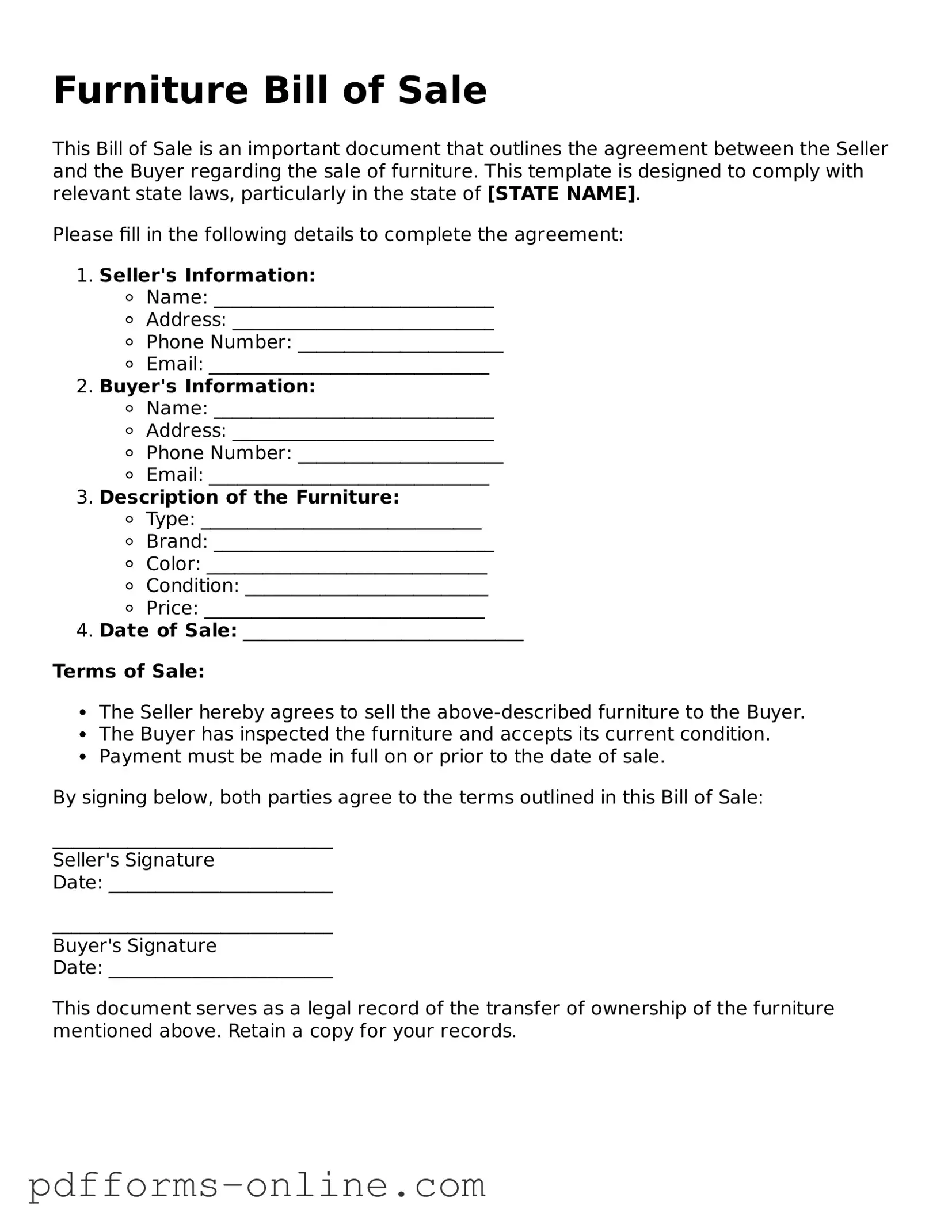The Vehicle Bill of Sale is a document used when buying or selling a motor vehicle. Similar to the Furniture Bill of Sale, it serves as proof of the transaction between the buyer and seller. This document typically includes details such as the vehicle's make, model, year, and Vehicle Identification Number (VIN), along with the purchase price and the date of sale. Just as with furniture, this bill protects both parties by providing a record of the transaction, which can be essential for registration and insurance purposes.
The Equipment Bill of Sale is another document that shares similarities with the Furniture Bill of Sale. It is used for the sale of equipment, whether for personal or business use. This document outlines the specifics of the equipment being sold, including its condition, model, and serial number. Both documents serve to confirm ownership transfer and can help resolve disputes that may arise post-sale, ensuring that both buyer and seller have a clear understanding of the terms of the transaction.
The Boat Bill of Sale is specifically for the sale of watercraft. Much like the Furniture Bill of Sale, it details the transaction between the buyer and seller, including information about the boat's make, model, and hull identification number. This document is crucial for registering the boat with state authorities and provides legal proof of ownership. Both bills of sale function to protect the interests of both parties and facilitate a smooth transfer of ownership.
The Real Estate Bill of Sale is used in property transactions, similar to how the Furniture Bill of Sale is utilized for tangible goods. While it typically accompanies a larger transaction involving real property, it serves to document the sale of personal property included in the transaction, such as appliances or furniture. Both documents act as a record of what was sold, ensuring that all parties are aware of the items being transferred and their respective values.
The Gun Bill of Sale is a document that records the sale of firearms. Like the Furniture Bill of Sale, it provides essential details about the item being sold, including its make, model, and serial number. This document is vital for legal compliance and helps to establish a clear chain of ownership. Both types of bills of sale ensure that the transaction is transparent and documented, protecting the rights of both the buyer and seller.
The Pet Bill of Sale is similar to the Furniture Bill of Sale in that it documents the transfer of ownership for a pet. This document typically includes details about the pet, such as breed, age, and any vaccinations or health records. Both bills of sale serve to formalize the transaction, providing proof of ownership and ensuring that both parties understand the terms of the sale, including any conditions or agreements related to the pet’s care.
The Business Bill of Sale is utilized when selling a business or its assets. It includes details about the business being sold, such as its name, location, and any included inventory or equipment. Similar to the Furniture Bill of Sale, this document serves as a formal record of the transaction, ensuring that both the buyer and seller are on the same page regarding the terms of the sale. This clarity helps to avoid potential disputes and ensures a smooth transition of ownership.
For those looking to understand the comprehensive aspects of a Motorcycle Bill of Sale, this document provides vital information regarding the transfer of ownership. It is not only a testament to the sale but also serves necessary legal functions, making it essential for both the buyer and seller to have this paperwork. To learn more, visit the detailed Motorcycle Bill of Sale guide.
The Art Bill of Sale is used for the sale of artwork and shares similarities with the Furniture Bill of Sale in that it documents the transfer of ownership. This document typically includes details about the artwork, such as the artist, title, medium, and any provenance information. Both bills of sale serve to protect the interests of both parties by providing a clear record of the transaction, which can be important for future resale or insurance purposes.
The Jewelry Bill of Sale is another document akin to the Furniture Bill of Sale. It is used when buying or selling jewelry and includes specifics such as the type of jewelry, any gemstones, and their respective qualities. This document not only serves as proof of the transaction but also helps establish the value of the item. Both types of bills of sale play a crucial role in ensuring that the sale is documented and understood by both parties, protecting their rights and interests.
